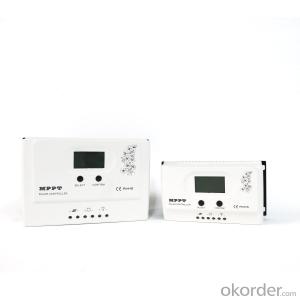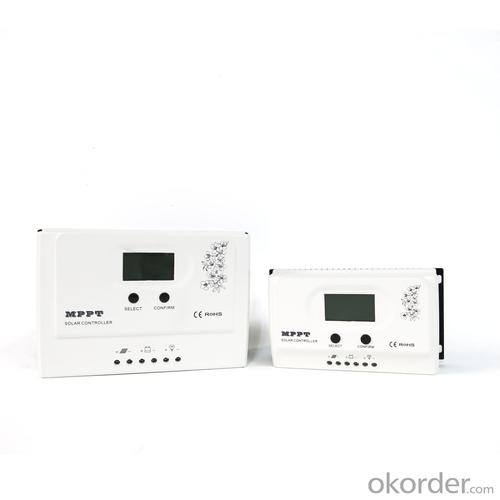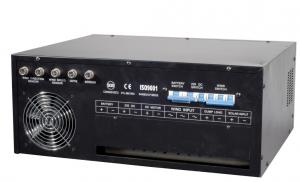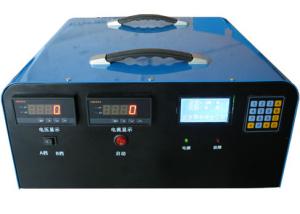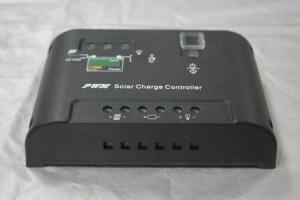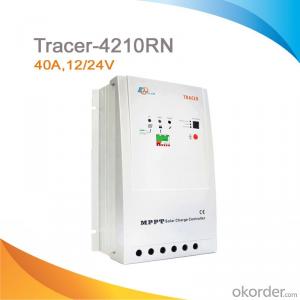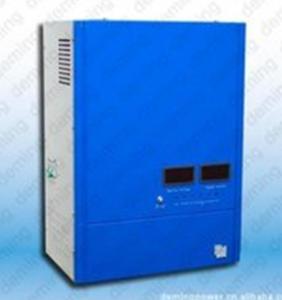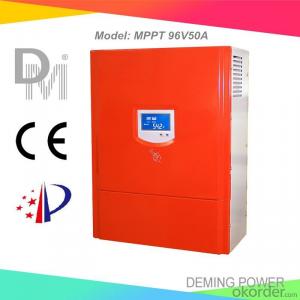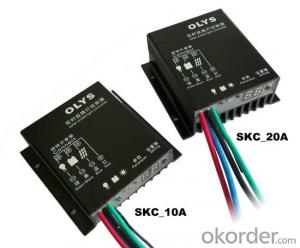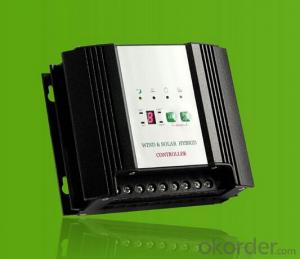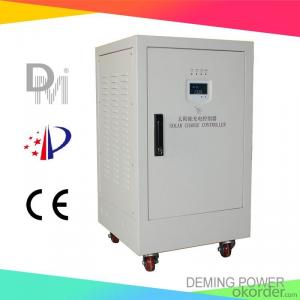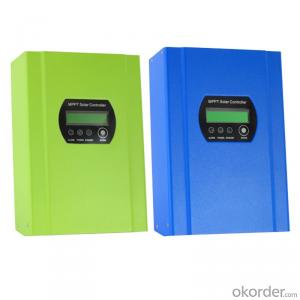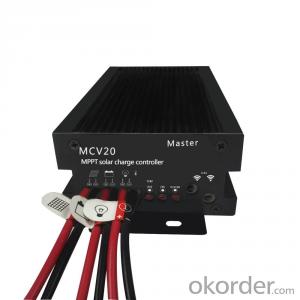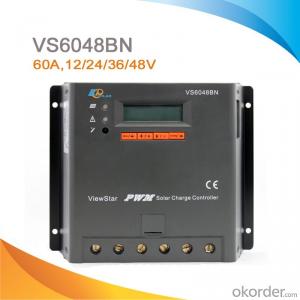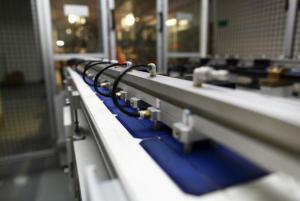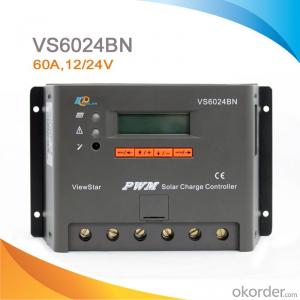Plasmatronics Solar Controllers - Max. PV Input 100V Solar Charge 12V/24V Controller 15A MPPT with LCD
- Loading Port:
- China main port
- Payment Terms:
- TT OR LC
- Min Order Qty:
- 20 unit
- Supply Capability:
- 9999 unit/month
OKorder Service Pledge
OKorder Financial Service
You Might Also Like
Max. PV Input 150V Solar Charge 12V/24V Controller 15A 20A 30A 40A 50A MPPT with LCD
I-P-Wiser 1 series adopted with auto cool, high conversion efficiency, LCD display and free PC software. It features an efficient MPPT control algorithm to track the maximum power point of the PV array in any environment. Greatly improve the utilization of solar panel. Also added the output function(USB 5V 3A). For the mppt controller can be widely used in off-grid solar system, Communication base station solar system, household solar systems, street light solar systems, field monitoring and other fields.

| Product Show |


| MPPT Controller connection diagram |

| Features |
1.High efficiency MPPT control algorithm, MPPT efficiency ≥99.5%, whole Machine conversion efficiency upto 98%;
2.12V/24V system Automatic Recognition,users can use it in different system conveniently.
3.Maximum PV input voltage: 100VDC(15A, 20A), 150VDC (30A, 40A,50A)
4.Charge mode: three stages (fast charge, constant charge, floating charge). It prolongs service life of the batteries.
5.Discharge mode: ON/OFF mode, PV voltage control mode.
6.Recommended battery types: sealed lead acid, vented, gel, NiCd battery. Other types of the batteries can also be defined.
7.Most information could be provided by LCD like: system type., PV input voltage, battery type, battery voltage, charging current, charging power, working status and so on. Also customer's information like company name, website and logo can be added into Solar Eagle software.
8.RS232 communication, we can offer communication protocol also, it’s convenient for user’s integration management.
9.CE, RoHS, FCC certifications approved.. We can help clients to approve other certifications.
10.2 years warranty. And 3~10 years extended warranty service also can be provided.
Upper Computer Software and Test Software |
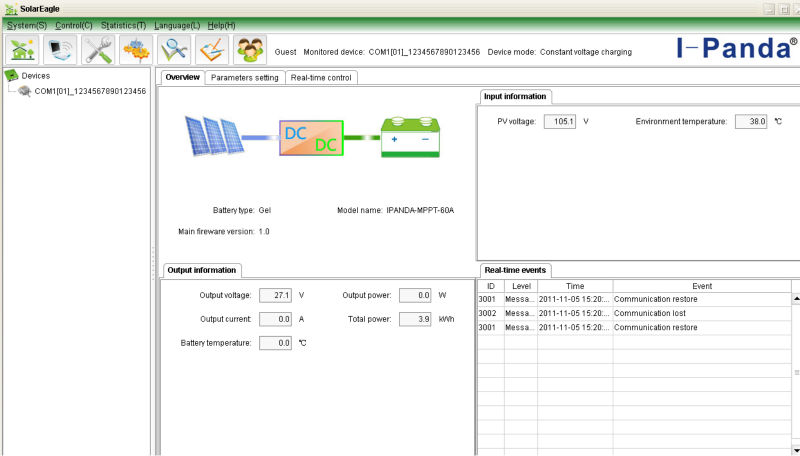
PC software_SolarEagle

Monitoring software
Visual display of charge and discharge status, PV voltage, charge voltage, charge current, and can set the battery type, LOAD output control;
parameters |
Model: | 15A | 20A | 30A | 40A | 50A | |
I-P-Wiser 1-12V/24V-Series | ||||||
Charge mode | MPPT(maximum power point tracking) | |||||
MPPT efficiency | ≥99.5% | |||||
System type | DC12V/24V system | Automatic Recognition | ||||
INPUT CHARACTERISTICS | ||||||
PV Max PV input voltage(VOC) | 12V/24V system | DC100V | DC150V | |||
Start the charging voltage point | 12V system | 18V | ||||
24V system | 32V | |||||
High input voltage protection point | 12V/24V system | DC100V | DC150V | |||
High input voltage recovery point | 12V/24V system | DC95V | DC145V | |||
Rated PV power | 12V system | 200W | 260W | 390W | 520W | 650W |
24V system | 400W | 520W | 780W | 1040W | 1300W | |
CHARGE CHRECTRESTICS | ||||||
Selectable Battery Types | 12V/24V system | Sealed lead-acid batteries, Vented batteries Gel, NiCd battery (Other types of the batteries also can be defined) | ||||
Charge method | 12V/24V system | Three stages charge: constant current(MPPT), constant voltage, floating charge | ||||
Charge rated current | 12V/24V system | 15A | 20A | 30A | 40A | 50A |
OUTPUT DISCHARGE CHARACTERISTICS | ||||||
USB (Total for 2 USB output) | DC5V 3A | |||||
LOAD output voltage | Based on battery voltage | |||||
Max. DC Load current | 30A | |||||
Output control mode | ON/OFF mode, PV voltage control mode | |||||
Output control set way | Controller button or PC software | |||||
DISPLAY | ||||||
LCD Display | System type, PV voltage,charge voltage, charging current, charging power, temperature etc. | |||||
PC software | RS232 | |||||
OTHER PARAMETERS | ||||||
Protection function | Yes (Over voltage, low voltage, over temperature, over load, Short circuit protection etc.) | |||||
Cooling mode | Auto cool | |||||
Type of Mechanical Protection | IP 30 | |||||
Measurement DxWxH (mm) | 200*110*66 | 243*155*79 | ||||
Packing DxWxH (mm) | 249*144*105 | 289*189*113 | ||||
N.W. (KG) | 0.9 | 1.8 | ||||
G.W. (KG) | 1.3 | 2.2 | ||||
Certifications |

F&Q: |
Q1. How to ensure and monitor the products quality?
A1: We have established a perfect Quality Management System, In strict
accordance with ISO9001: 2008 quality system and ISO14001 environment system for quality assurance management;
Our ISO9001:2008 Quality System certificate encoding: CHIN/TW/QMS/00119;
Our ISO14001 Environment System certificate encoding: CHIN/TW/EMS/00028;
Q2. What is the warranty of products?
A2: The warranty period of different products are different; 5 years, 3 years, 2 years, 1 years; More details please refer to the product specification or manual; we will provide free life-long technical support ;
Q3. What is the difference between MPPT&PWM?
A3. MPPT charging mode, peak efficiency up to 99%, saving 30%~60% solar panel than traditional PWM controller.
- Q: Can a solar controller be used with solar-powered agricultural equipment?
- Yes, a solar controller can be used with solar-powered agricultural equipment. A solar controller regulates and optimizes the charging and discharging of batteries in the solar system, ensuring efficient energy management. It is essential for controlling the flow of power from the solar panels to the equipment, protecting the batteries from overcharging, and extending their lifespan. Therefore, a solar controller plays a crucial role in the effective operation of solar-powered agricultural equipment.
- Q: Solar panels for solar panels
- Cancel the potentiometer to adjust the control set point, and the use of E-side memory records the work of the control point, so that set the digital, eliminating the potential deviation due to potentiometer, temperature drift, so that the control point error reduction accuracy, reliability Factor; use of digital LED display and settings, one-button operation to complete all settings, the use of extremely convenient and intuitive role is to control the work of the entire system, and the battery played a charge protection, over discharge protection role. In the larger temperature difference, the qualified controller should also have the function of temperature compensation. Other additional functions such as light control switch, time control switch should be the option of the controller;
- Q: What is the purpose of the battery temperature compensation feature on a solar controller?
- The purpose of the battery temperature compensation feature on a solar controller is to ensure optimal charging and discharging of the battery in varying temperature conditions. Batteries are sensitive to temperature, and their performance can be affected by extreme hot or cold temperatures. When a battery is exposed to high temperatures, it can experience accelerated chemical reactions, leading to increased self-discharge, reduced capacity, and shorter overall lifespan. On the other hand, extremely cold temperatures can cause a decrease in battery efficiency and capacity. To mitigate these temperature-related issues, solar controllers equipped with battery temperature compensation feature monitor the temperature of the battery and adjust the charging and discharging parameters accordingly. By measuring the battery's temperature, the controller can accurately determine the voltage and current levels required to safely charge the battery. During hot temperatures, the battery temperature compensation feature reduces the charging voltage to prevent overcharging and excessive heat generation, thus protecting the battery from potential damage. Conversely, in cold temperatures, the compensation feature increases the charging voltage to counteract the decrease in battery capacity caused by lower temperatures. By adjusting the charging and discharging parameters based on the battery's temperature, the battery temperature compensation feature optimizes the battery's performance, extends its lifespan, and ensures that it operates within safe operating conditions. This feature is particularly crucial in solar systems where batteries are exposed to varying temperature conditions, such as in off-grid or remote locations.
- Q: What is the role of a solar controller in preventing battery stratification?
- The role of a solar controller in preventing battery stratification is to regulate the charging process of the battery. It ensures that the battery is charged evenly and prevents overcharging, which can lead to stratification. By monitoring and adjusting the charging voltage and current, the solar controller helps maintain a consistent charge across the battery, preventing the accumulation of acid at the bottom and water at the top. This helps to prolong the battery's lifespan and optimize its performance.
- Q: Is it possible to connect multiple solar controllers together?
- Yes, it is possible to connect multiple solar controllers together. This can be done by connecting the outputs of each solar controller in parallel, which allows them to work together to charge a common battery bank. However, it is important to ensure that the combined capacity of the solar controllers does not exceed the maximum charging capacity of the battery bank. Additionally, proper wiring and sizing of cables should be followed to minimize voltage drop and ensure efficient operation. It is also advisable to consult the manufacturer's guidelines and specifications to ensure compatibility and avoid any potential issues.
- Q: Can I connect a solar controller directly to my battery bank?
- No, it is not recommended to connect a solar controller directly to a battery bank. A solar controller regulates the charging process and prevents overcharging, which is crucial for the longevity and performance of the batteries. Connecting it directly to the battery bank may result in damage to the batteries and reduced efficiency of the solar system.
- Q: What is the temperature range in which a solar controller operates?
- The temperature range in which a solar controller operates typically varies from -40 degrees Celsius to 85 degrees Celsius.
- Q: Can a solar controller be used with a solar-powered security camera?
- Yes, a solar controller can be used with a solar-powered security camera. A solar controller regulates the charging of the battery connected to the solar panel, ensuring optimum power supply to the camera. It helps manage the solar energy generated and prevents overcharging or undercharging of the battery, thus extending the camera's operating life.
- Q: What is the maximum power capacity that a solar controller can handle?
- The maximum power capacity that a solar controller can handle varies depending on the specific model and its design. However, most modern solar controllers can handle power capacities ranging from 10 to 60 amps or more, allowing them to efficiently regulate and control the charging and discharging of solar batteries within that range.
- Q: What is the role of a solar controller in preventing battery undercharging?
- Ensuring the longevity and optimal performance of solar battery systems relies heavily on the crucial role played by a solar controller in preventing battery undercharging. Acting as a mediator between the solar panels and batteries, the solar controller effectively regulates the energy flow and safeguards against undercharging. When electricity is generated by solar panels, it is initially in the form of direct current (DC) and must be converted and controlled before being stored in the batteries. This task is effectively carried out by a solar controller, which continuously monitors the voltage and current levels of both the solar panels and batteries. Among the primary functions of a solar controller is the prevention of battery overcharging, which can cause damage or reduce the batteries' lifespan. However, it is equally important in averting battery undercharging. Undercharging occurs when the batteries do not receive enough charge to reach their full capacity, resulting in diminished performance and a shortened lifespan. To address this issue, the solar controller consistently monitors the battery voltage and adjusts the charging current accordingly. It ensures that the batteries receive an adequate amount of charge to replenish any energy consumed, thereby maintaining them at an optimal state of charge. The solar controller employs a charge algorithm that takes various factors into account, including battery type, ambient temperature, and charging conditions, to determine the appropriate charging current. By adjusting the charging voltage to align with the battery manufacturer's specifications, the solar controller effectively prevents both overcharging and undercharging. Furthermore, solar controllers often incorporate additional features such as temperature compensation and low voltage disconnect (LVD) to further safeguard against battery undercharging. Temperature compensation adjusts the charging voltage based on the ambient temperature, ensuring optimal charging regardless of weather conditions. LVD protects the batteries by disconnecting loads when the voltage falls below a specific threshold, thus preventing excessive discharge and undercharging. In summary, the role of a solar controller in preventing battery undercharging revolves around regulating the energy flow from solar panels to batteries, constantly monitoring voltage and current levels to guarantee a sufficient charge. By preventing undercharging, the solar controller maximizes the performance, lifespan, and overall efficiency of solar battery systems.
Send your message to us
Plasmatronics Solar Controllers - Max. PV Input 100V Solar Charge 12V/24V Controller 15A MPPT with LCD
- Loading Port:
- China main port
- Payment Terms:
- TT OR LC
- Min Order Qty:
- 20 unit
- Supply Capability:
- 9999 unit/month
OKorder Service Pledge
OKorder Financial Service
Similar products
Hot products
Hot Searches
Related keywords
